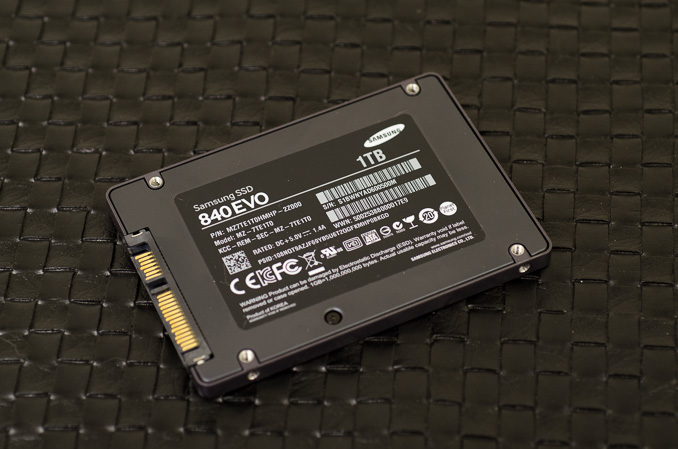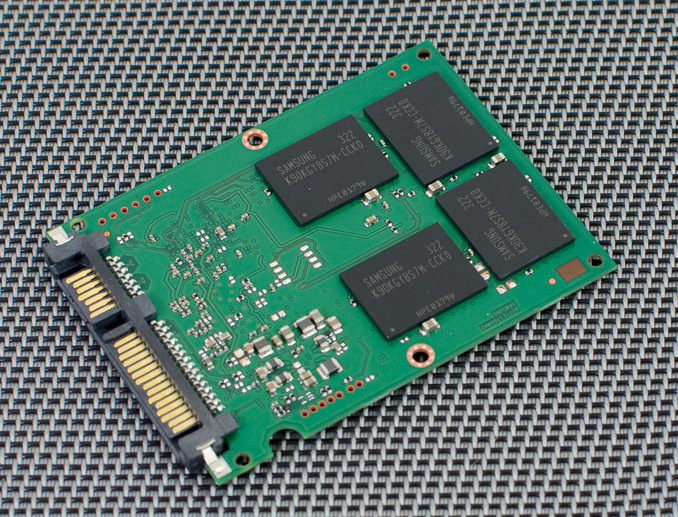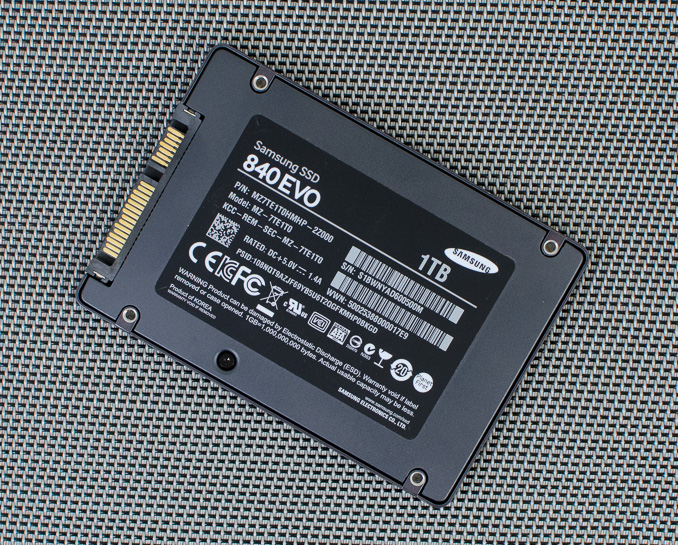Samsung SSD 840 EVO Review: 120GB, 250GB, 500GB, 750GB & 1TB Models Tested
by Anand Lal Shimpi on July 25, 2013 1:53 PM EST- Posted in
- Storage
- SSDs
- Samsung
- TLC
- Samsung SSD 840

I'm continually amazed by Samsung's rise to power in the SSD space. If you compare their market dominating products today to what we were reviewing from Samsung just a few years ago you'd assume they came from a different company. The past three generations of Samsung consumer SSDs have been good, but if you focus exclusively on the past two generations (830/840) they've been really good.
Last year Samsung bifurcated its consumer SSD lineup by intoducing the 840 Pro in addition to the vanilla 840. We'd seen other companies explore a similar strategy, but usually by playing with synchronous vs asynchronous NAND or sometimes just using different NAND suppliers between lines. Samsung used NAND to differentiate the two but went even more extreme. The non-Pro version of the 840 was the first large scale consumer SSD made with 3-bit-per-cell MLC NAND, more commonly known as TLC (triple-level-cell) NAND. Companies had toyed with the idea of going TLC well before the 840's release but were usually stopped either by economic or endurance realities. The 840 changed all of that. Although it didn't come with tremendous cost savings initially, over time the Samsung SSD 840 proved to be one of the better values on the market - you'd just have to get over the worry of wearing out TLC NAND.
Despite having a far more limited lifespan compared to its 2bpc MLC brethren, the TLC NAND Samsung used in its 840 turned out to be quite reliable. Even our own aggressive estimates pegged typical client write endurance on the 840 at more than 11 years for the 128GB model.
We haven't seen Samsung's love of TLC embraced by other manufacturers. The most significant contrast actually comes from Micron, another NAND supplier turned SSD manufacturer, and its M500. Relying on 2bpc MLC NAND, the M500 gets its cost down by using a combination of large page/block sizes (to reduce overall die area) as well as aggressively embracing the latest NAND manufacturing processes (in this case 20nm). That's always been the Intel/Micron way - spend all of your time getting to the next process node quickly, and drive down cost that way rather than going TLC. The benefit of the TLC approach is the potential for even more cost reduction, but the downside is it usually takes a while to get production to yield high enough endurance TLC to make it viable for use in SSDs. The question of which is quicker is pretty simple to answer. If we look at the 25nm and 20nm generations from IMFT, the manufacturer was able to get down to new process nodes quicker than Samsung could ship TLC in volume.
The discussion then shifts to whether or not TLC makes sense at that point, or if you'd be better off just transitioning to the next process node on MLC. Samsung clearly believes its mainstream TLC/high-end MLC split makes a lot of sense, and seeing how the 840 turned out last time I tend to agree. It's not the only solution, but given how supply constrained everyone is on the latest NAND processes this generation - any good solution to get more die per wafer is going to be well received. Samsung doesn't disclose die areas of its NAND, so we unfortunately can't tell just how much more area efficient its TLC approach is compared to IMFT's 128Gb/16K page area efficient 20nm MLC NAND.
As with any other business in the tech industry, it turns out that a regular, predictable release cadence is a great way to build marketshare. Here we are, around 9 months after the release of the Samsung SSD 840 and we have its first successor: the 840 EVO.
As its name implies, Samsung's SSD 840 EVO is an evolution over last year's SSD 840. The EVO still uses 3-bit-per-cell TLC NAND, but it moves to a smaller process geometry. Samsung calls its latest NAND process 10nm-class or 1x-nm, which can refer to feature sizes anywhere from 10nm to 19nm but we've also heard it referred to as 19nm TLC. The new 19nm TLC is available in capacities of up to 128Gbit per die, like IMFT's latest 20nm MLC process. Unlike IMFT's 128Gb offering, Samsung remains on a 8KB page size even with this latest generation of NAND. The number of pages per block is also more like IMFT's previous 64Gbit 20nm MLC at 256:
| IMFT vs. Samsung NAND Comparison | ||||||||||||||
| IMFT 20nm MLC | IMFT 20nm MLC | Samsung 19nm TLC | Samsung 21nm TLC | Samsung 21nm MLC | ||||||||||
| Bits per Cell | 2 | 2 | 3 | 3 | 2 | |||||||||
| Single Die Max Capacity | 64Gbit | 128Gbit | 128Gbit | 128Gbit | 64Gbit | |||||||||
| Page Size | 8KB | 16KB | 8KB | 8KB | 8KB | |||||||||
| Pages per Block | 256 | 512 | 256 | 192 | 128 | |||||||||
| Read Page (max) | 100 µs | 115 µs | ? | ? | ? | |||||||||
| Program Page (typical) | 1300 µs | 1600 µs | ? | ? | ? | |||||||||
| Erase Block (typical) | 3 ms | 3.8 ms | ? | ? | ? | |||||||||
| Die Size | 118mm2 | 202mm2 | ? | ? | ? | |||||||||
| Gbit per mm2 | 0.542 | 0.634 | ? | ? | ? | |||||||||
| Rated Program/Erase Cycles | 3000 | 3000 | 1000 - 3000 | 1000 - 3000 | 3000 (?) | |||||||||
The high level specs, at least those Samsung gives us, points to an unwillingness to sacrifice latency even further in order to shrink die area. The decision makes sense since TLC is already expected to have 50% longer program times than 2bpc MLC. IMFT on the other hand has some latency to give up with its MLC NAND, which is why we see the move to 2x larger page and block sizes with its 128Gbit NAND die. Ultimately that's going to be the comparison that's the most interesting - how Samsung's SSD 840 EVO with its 19nm TLC NAND stacks up to Crucial's M500, the first implementation of IMFT's 128Gbit 20nm MLC NAND.
Modern Features
Along with the NAND update, the EVO also sees a pretty significant controller upgrade. The underlying architecture hasn't changed, Samsung's MEX controller is still based on the same triple-core Cortex R4 design as the previous generation MDX controller. The cores now run at 400MHz compared to 300MHz previously, which helps enable some of the higher performance on the EVO. The MEX controller also sees an update to SATA 3.1, something we first saw with SanDisk's Extreme II. SATA 3.1 brings a number of features, one of the most interesting being support for queued TRIM commands.
The EVO boasts hardware AES-256 encryption, and has its PSID printed on each drive label like Crucial's M500. In the event that you set and lose the drive's encryption key, you can use the PSID to unlock the drive (although all data will be lost). At launch the EVO doesn't support TCG Opal and thus Microsoft's eDrive spec, however Samsung tells us that a firmware update scheduled for September will enable both of these things - again bringing the EVO to encryption feature parity with Crucial's M500.
As one of the world's prominent DRAM makers, it's no surprise to find a ton of DRAM used to cache the firmware and indirection table on the EVO. DRAM size scales with capacity, although Samsung tosses a bit more than is necessary at a couple capacity points (e.g. 250GB).
| Samsung SSD 840 EVO DRAM | |||||||
| 120GB | 250GB | 500GB | 750GB | 1TB | |||
| DRAM Size | 256MB LPDDR2-1066 | 512MB LPDDR2-1066 | 512MB LPDDR2-1066 | 1GB LPDDR2-1066 | 1GB LPDDR2-1066 | ||
The move to 19nm 128Gbit TLC NAND die paves the way for some very large drive capacities. Similar to Crucial's M500, the 840 EVO is offered in configurations of up to 1TB.
| Samsung SSD 840 EVO Specifications | ||||||||||||
| 120GB | 250GB | 500GB | 750GB | 1TB | ||||||||
| Controller, Interface | Samsung MEX, SATA 3.1 | |||||||||||
| NAND | Samsung 19nm 3bpc TLC Toggle DDR 2.0 NAND | |||||||||||
| Form Factor | 2.5" 7mm | |||||||||||
| Max Sequential Read |
540MB/s
|
|||||||||||
| Max Sequential Write |
410MB/s
|
520MB/s
|
||||||||||
| Max 4KB Random Read |
94K IOPS
|
97K IOPS
|
98K IOPS
|
|||||||||
| Max 4KB Random Write |
35K IOPS
|
66K IOPS
|
90K IOPS
|
|||||||||
| Encryption | AES-256 FDE, PSID printed on SSD label | |||||||||||
| Warranty | 3 years | |||||||||||
I'll get to the dissection of performance specs momentarily, but you'll notice some very high peak random and sequential performance out of these mainstream drives. The peak performance improvement over last year's 840 is beyond significant. The keyword there is peak of course.
Pricing
Samsung expects the 840 EVO to be available in the channel at the beginning of August. What we have in the table below are suggested MSRPs, which as long as supply isn't limited usually end up being higher than street prices:
| SSD Pricing Comparison - 7/24/2013 | |||||||
| 120/128GB | 240/250/256GB | 480/500/512GB | 750GB | 960GB/1TB | |||
| Crucial M500 | $120.99 | $193.56 | $387.27 | $599.99 | |||
| Intel SSD 335 | $219.99 | ||||||
| Samsung SSD 840 | $98.44 | $168.77 | $328.77 | ||||
| Samsung SSD 840 EVO | $109.99 | $189.99 | $369.99 | $529.99 | $649.99 | ||
| Samsung SSD 840 Pro | $133.49 | $230.95 | $458.77 | ||||
| SanDisk Extreme II | $129.99 | $229.77 | $449.99 | ||||
| SanDisk Ultra Plus | $96.85 | $174.29 | |||||
| OCZ Vertex 450 | $129.99 | $246.84 | |||||
Prices are a bit higher than the outgoing Samsung SSD 840, which makes sense since we're looking at the beginning of the cost curve of a new process node. Crucial's highly sought after $600 960GB M500 seems finally back in stock just in time for the EVO to go head to head with it. Samsung is expecting roughly a $50 premium for the 1TB EVO over the Crucial solution, but over time I'd expect that gap to shrink down to nothing (or in favor of Samsung). The EVO is considerably more affordable than Samsung's 840 Pro, and the higher capcacity points are at particularly tempting prices.












137 Comments
View All Comments
Riven98 - Thursday, July 25, 2013 - link
Anand,Thanks for the great article. I had just been thinking that there had been a downturn in the number of articles like these, which are the main reasons I visit on an almost daily basis.
chrnochime - Friday, July 26, 2013 - link
Still recommending a technology that's known to not last as long as the MLC. Yes the *extropolated* result indicates that its lifetime is far longer than advertised, but really, why when even M500 is not that slow in the first place and cost about the same, why risk going with the TLC? Not to mention Samsung's 830 has its fair share of horror stories as well...watersb - Friday, July 26, 2013 - link
Excellent review.How does write amplification scale as the disk fills up? Wouldn't a full disk fail more rapidly than a half-full one?
BobAjob2000 - Tuesday, January 28, 2014 - link
Hopefully wear leveling and TRIM/garbage collection algorithms should take care of your concerns. They should take existing unchanged 'cold' data and move it around to make way for regularly changed 'hot' data. This should reduce the impact of both data longevity and write amplification as it guides new writes to hit the 'freshest' unused or rarely written blocks on the disk and also helps to ensure that data goes not go 'stale' after being untouched for years. Different vendors use different algorithms that have evolved and improved over time. I think Samsung (being a RAM manufacturer) can possibly provide better RAM caches for their disks that may provide advantages for garbage collection and wear leveling algorithms by improving the available 'thinking space' for the caching and sorting/organizing of 'hot' data.Its all to do with managing the 'temperature' of your data somewhat like a data 'weather forecast' which can be very useful in the short term or for simple predictable/settled patterns but less practical for long term or unseasonal data storms.
Would like to see these things tested by 'what if' scenarios though to demonstrate the differences between different vendors algorithms.
xtreme2k - Friday, July 26, 2013 - link
Can anyone tell me why I am paying 90% of the price for 33% of the endurance of a drive?MrSpadge - Saturday, July 27, 2013 - link
Because endurance doesn't matter (very likely also for you), but price does.log - Friday, July 26, 2013 - link
Can you partition this drive and still take advantage of its features? ThnaksTimur Born - Friday, July 26, 2013 - link
I don't quite understand exactly why the Samsung RAPID software cache brings higher performance in *practice* than Windows' own cache? Using two software caches will lead to the same information being stored in RAM twice or even thrice, which is exactly what the Windows cache tries to avoid since XP days.That the usual benchmark programs get fooled is visible, as they think to be working without a software cache. So the higher values there are not surprising. But I am a bit puzzled why the Anand Storage Bench results increase, too?! Why is RAPID software caching better than Windows' own cache in this scenario? Or does the ASB bypass Windows' cache, too (like most benchmarks)?
By the way: ATTO allows the Windows cache to be turned ON for testing. My "old" Crucial M4 256 gets sees very high read results once ATTO makes use of Windows' cache. Only the write rates remain significantly smaller.
Therefor an ATTO test with combinations of either or both software caches (RAPID and Windows) would be interesting.
MrSpadge - Saturday, July 27, 2013 - link
I think it's because Samsung is being much more agressive with caching than Win dares to be, i.e. it holds files far longer before writing them, so they can be combined more efficiently but are longer at risk of being lost.Timur Born - Sunday, July 28, 2013 - link
I am not convinced about that yet, especially since you can turn off drive cache flushing via Device-Manager and thus should get an even more aggressive Windows cache behavior than what RAPID offers (which is reported to adhere to Windows' flush commands).The Windows cache is designed to keep data in RAM for as long as it's not needed for something else. Even more important, data is *directly* executed from inside the Windows cache instead of being copied back and forth between separate memory regions. This keeps duplication to a minimum (implemented since XP as far as I remember). So at least for reads the Windows cache is very useful, especially in combination with Superfetch, which is *not* disabled for SSDs btw (even Prefetch for the boot phase isn't disabled, but in practice it makes not much of a difference whether you boot with or without Prefetch from an SSD).
There is something funky going on with Windows' cache and the drive's onboard cache of my Crucial M4 in combination with ATTO (Windows cache enabled). Different block sizes get very different results, with some *larger* block sizes not benefiting from Windows' cache either at read or write, the latter depending on the block size chosen. Turning the drive's own cache flushing on/off via Device-Manager can have an impact on that, too.
In some cases I get less throughput with Windows cache than without (i.e. 512 kb block size with drive flushing on). This may be an issue of ATTO, though, because I also got some measurements where ATTO claimed a write speed of zero (0)! Turning off either drive cache flushing or the Windows cache or both helps ATTO to get meaningful measurements again.
So the main question remains: How and why would RAPID affect "real-world" performance on top of the Windows cache and does the Anand Storage Bench deliberately circumvent the Windows cache?
The reason I was looking at this review was that I am currently looking for a new SSD to build a desktop PC and the 840 EVO looks like the thing to buy. So once I get my hands on one myself I will just try RAPID myself. ;)